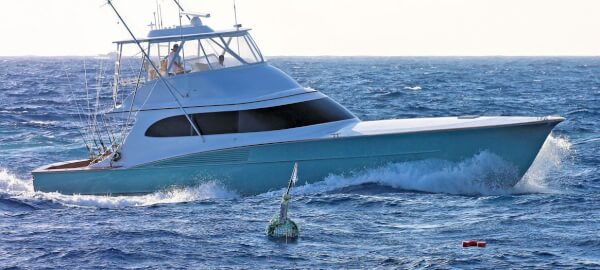There’s a saying among sport fishermen: The name of the sport is fishing, not catching. Now, an ages old concept is receiving renewed interest by sport fishermen. Fish Aggregating Devices (FADs) are on the rise in waters off many Caribbean islands for their ability to turn fishing into catching.
FADs are man-made structures that float on top of the ocean. Most FADs are constructed out of buoys or floats tethered by thousands of feet of rope to an anchor placed on the sea floor. In the Dominican Republic, FADs are built out of Styrofoam with typically a coconut palm frond attached to it on the top. In Antigua, many FADs are crafted using large heavy nylon netting.
FADS attract fish in much the same way as flotsam drifting in the current. That is, bait fish collect in its shade and entice larger predators to come and feed.
“Billfish have been seen numerous times around FADs as two primary species that they hunt are often found around it, which are mahi-mahi and small to medium sized tuna,” says Robert Hall, of AquaSports, in Antigua.
FADs, as mentioned, aren’t something new. The idea for these devices off islands such as the Dominican Republic was started by local artisanal fishermen who would deploy their FADs in order to come back again and again to catch fish to bring to market.

“As sport fishing became more popular in the Dominican Republic during the last decade, those seeking billfish started marking the FADs in their GPS and fishing around them with tremendous results,” explains Rick Alvarez, whose Miami, Florida-based company, International Billfish Tournaments, annually runs the Casa De Campo Blue Marlin Classic and Cap Cana Billfish Shootout.
Today, there are some 40 FADs located 16 to 30 miles off the area of Macao, off Cap Cana. In Casa de Campo, there are even more. Hall says dozens of FADs have been placed off Antigua, the majority of which are on the eastern Atlantic side of the island where the water is deeper than the Caribbean Sea. In St. Lucia, there are five FADs located from the northwest to the southeast coast. However, the most popular and successful are those off the west coast fishing villages, according to Sean Devaux, operations manager at IGY’s Rodney Bay Marina, host of the annual International St. Lucia Billfish Tournament, which takes place this month in October.
“FADs are being used more and more during tournaments. This is because fishermen know they stand a better chance of catching more fish there than simply trolling the drop off as they would have in the past,” says Antigua’s Hall.
The key is for anglers to practice responsible fishing and not get lost in a hooking frenzy,” says Ellen Peel, president of the Fort Lauderdale, Florida-headquartered conservation-oriented, The Billfish Foundation.
St. Lucia’s Devaux agrees and adds, “Last year more than 97 percent of the bill fish released in our tournament were in and around the southern FAD.”

Puerto Rico installed seven FADs over the last year. Four to the east of the San Juan Bay (in front of the Capitol building in Puerto de Tierra; the hotels in the Condado area; Cangrejos, and Vacia Talega in Loíza), with the other three to the west of San Juan Bay in Dorado, Vega Baja and Manatí. A total of 30 FADs are planned for the island’s waters over the next year. Salvador Egea, Jr., director of Club Nautico de San Juan’s International Billfish Tournament, was especially pleased with what these devices brought to the Club’s tournament in September.
“The boats were coming and reporting multiple bites. The fishing is hot now!” says Egea.
From a sport fishing perspective, FADs do offer advantages of saved fuel, less time finding the fish and increased likelihood of hooking a fish.
“The key is for anglers to practice responsible fishing and not get lost in a hooking frenzy,” says Ellen Peel, president of the Fort Lauderdale, Florida-headquartered conservation-oriented, The Billfish Foundation.
Carol M. Bareuther, RD, is a St. Thomas, U.S. Virgin Islands based marine writer and registered dietitian.





How can All at Sea support the hazard to navigation these devices represent? They are not lit and many have a low profile, making them difficult to see in larger waves.
Sailing off the northern coast of Dominica three years ago and following the accepted practices of making the passages at night, we snagged one of these at 03:00 AM. It took me the better part of an hour, under my boat, to cut the the lines wrapped around my propeller and rudder, so that we could continue our passage before the trade winds picked up. Even with winds at less than 15 knots and waves four to five feet, it is not an experience I would wish on anyone.
These may not present a hazard to those who only venture forth in settled weather and daylight hours, but for most cruisers, night passages are common and these devices present an unacceptable navigational hazard.
I don’t know that an educational article on their existence and use qualifies as “support,” right?